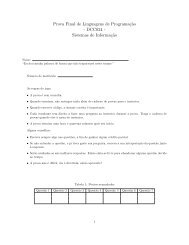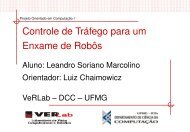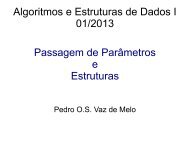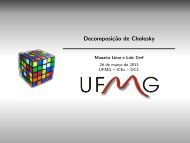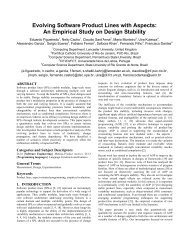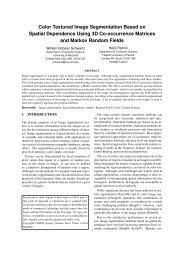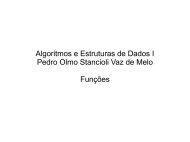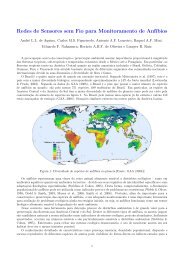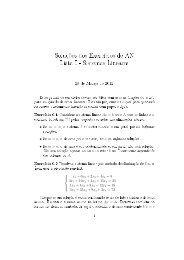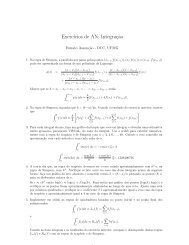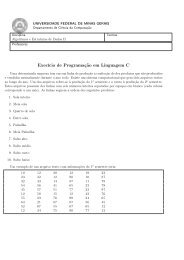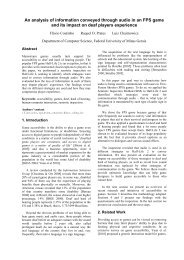A Geographical Analysis of Knowledge Production ... - ResearchGate
A Geographical Analysis of Knowledge Production ... - ResearchGate
A Geographical Analysis of Knowledge Production ... - ResearchGate
You also want an ePaper? Increase the reach of your titles
YUMPU automatically turns print PDFs into web optimized ePapers that Google loves.
pages <strong>of</strong> the respective institutions the names <strong>of</strong> the faculty<br />
members <strong>of</strong> the 30 graduate programs. In the second step,<br />
using the names <strong>of</strong> these faculty members, we collected from<br />
DBLP their respective pages, the pages <strong>of</strong> their coauthors,<br />
and the pages <strong>of</strong> the coauthors <strong>of</strong> these coauthors, extracting<br />
from them the corresponding publication data. All this<br />
data was stored in a relational database in order to provide<br />
us with a flexible querying environment. Finally, in<br />
the third step, we associated each publication venue (conference<br />
or journal) in the database to a specific Computer<br />
Science subfield. For this, we used a list <strong>of</strong> 30 Computer<br />
Science subfields that reflect the special interest groups <strong>of</strong><br />
the Brazilian Computer Society, as shown in Table 1.<br />
This data gathering process summed up 176,537 authors<br />
and 352,766 publications (conference papers and journal articles),<br />
distributed among 2,176 distinct venues. The data<br />
was collected from the DBLP repository on June 27, 2007,<br />
and refer to articles published between 1954 and 2007. These<br />
numbers are summarized in Table 2. Figure 1 shows the<br />
number <strong>of</strong> authors and the number <strong>of</strong> publications over a<br />
period <strong>of</strong> 12 years, from 1994 to 2006. Notice that the number<br />
<strong>of</strong> papers grows faster than the number <strong>of</strong> authors in the<br />
period, since older authors continue to establish connections<br />
over time.<br />
Table 1: Computer Science Subfields<br />
Algorithms and Theory Applied Computing<br />
Artificial Intelligence Bioinformatics<br />
Circuit Conception Computer Architecture<br />
Computer Graphics<br />
Computer Networks and<br />
Distributed Systems<br />
Computer Vision Data Mining<br />
Databases<br />
Formalisms, Logics and<br />
Semantics<br />
Geoinformatics<br />
Embedded Systems and<br />
Real-Time Systems<br />
Games and<br />
Entertainment<br />
Human-Computer<br />
Interaction<br />
Informatics in Education Information Retrieval<br />
Information Systems Machine Learning<br />
Modelling and<br />
Simulation<br />
Operation Systems<br />
Programming Languages<br />
Natural Language<br />
Processing<br />
Operational Research<br />
and Optimization<br />
Robotics, Automation<br />
and Control<br />
Security and Privacy S<strong>of</strong>tware Engineering<br />
Ubiquitous Computing<br />
Web, Hypermedia<br />
Systems, Multimedia<br />
4. COAUTHORSHIP NETWORKS<br />
In this section we describe the three coauthorship networks,<br />
generated from data gathered from DBLP, and present<br />
some statistics about them. Before that, we discuss some so-<br />
Number <strong>of</strong> Items<br />
350000<br />
300000<br />
250000<br />
200000<br />
150000<br />
100000<br />
50000<br />
Authors<br />
Papers<br />
Table 2: Data Summary<br />
Programs 30<br />
Authors 176,537<br />
Publications 352,766<br />
Venues 2,176<br />
0<br />
1994 1996 1998 2000<br />
Time (years)<br />
2002 2004 2006<br />
Figure 1: Number <strong>of</strong> Authors and Number <strong>of</strong> Papers<br />
over Time<br />
cial network fundamentals.<br />
4.1 Fundamentals<br />
Collaboration social networks are modeled as undirected,<br />
unweighted graphs, in which there is an edge between two<br />
actors if they have collaborated at least once during a certain<br />
period <strong>of</strong> time. In a coauthorship network, nodes represent<br />
authors, and two authors are connected by an edge if they<br />
have coauthored one or more papers, as shown in Figure 2.<br />
Figure 2: A Coauthorship Network<br />
The modelling <strong>of</strong> a coauthorship network as a graph allows<br />
the use <strong>of</strong> some interesting measures. A possibility is the<br />
connected component analysis, which consists in measuring<br />
the size <strong>of</strong> the giant component (or the largest connected<br />
component) [15]. A connected component is a maximal connected<br />
subgraph. Two vertices are in the same connected<br />
component if and only if there exists a path between them.<br />
The measure consists in computing the fraction <strong>of</strong> graph<br />
vertices that are part <strong>of</strong> the giant component.<br />
The distance between two nodes <strong>of</strong> a network is the length<br />
<strong>of</strong> the shortest path between them. The average distance



